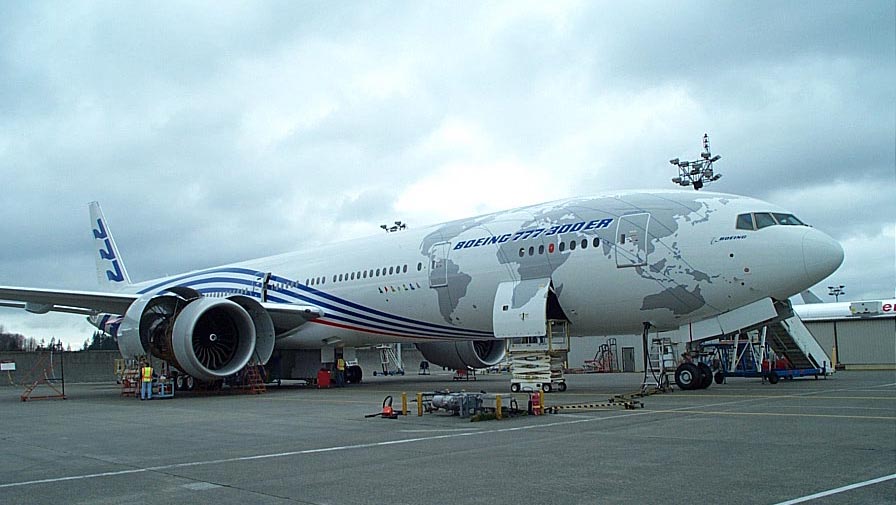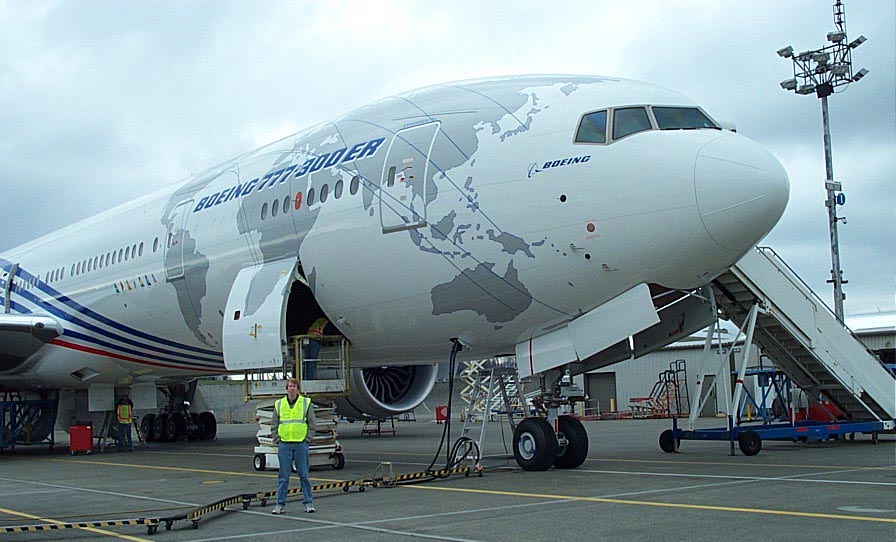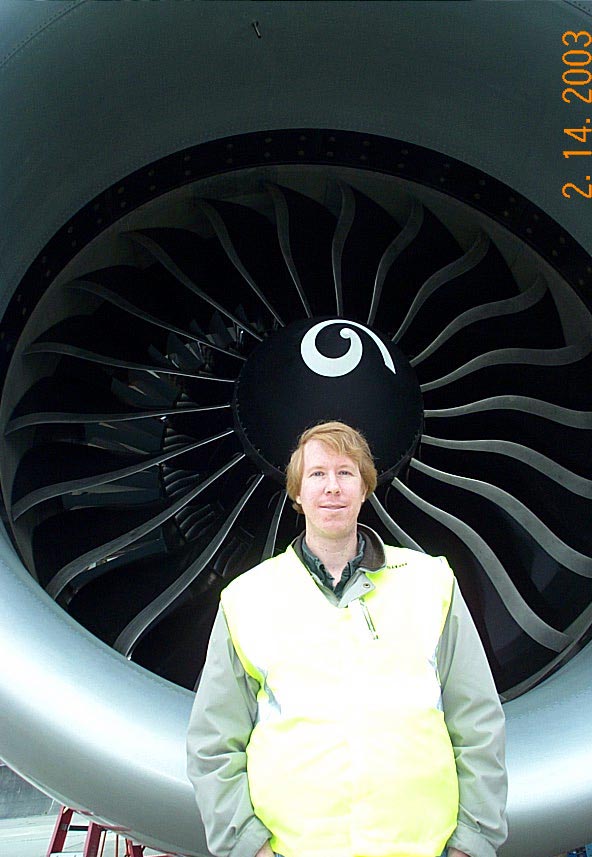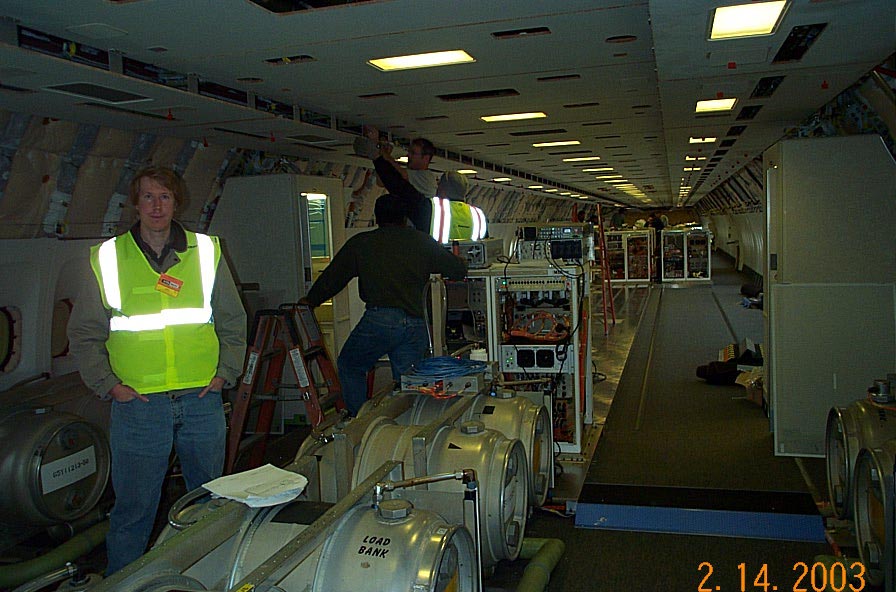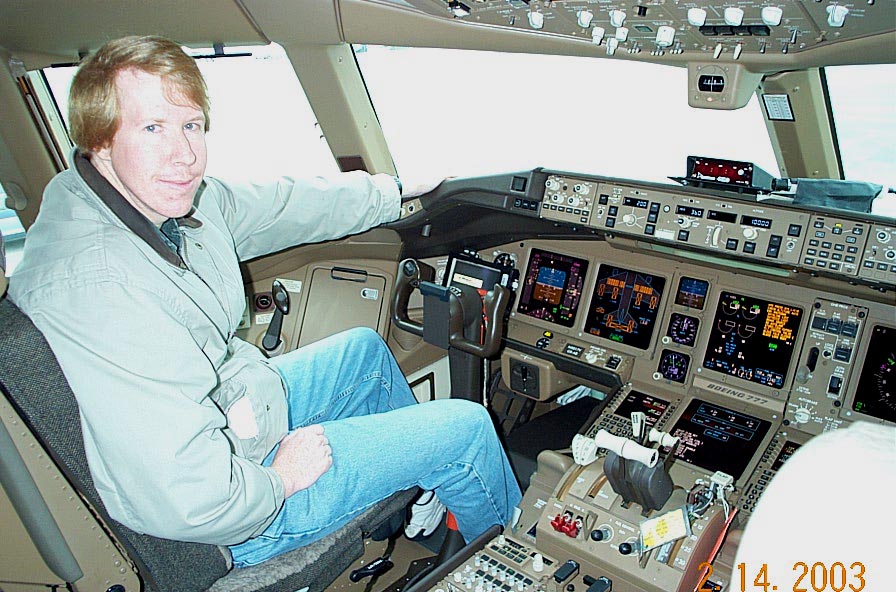“The Train”
November 26, 2002“The Abyss”
March 26, 2003“The Long Room” (February 15, 2003)
“Hang on, let me see for myself what is going on down there!”
The tech opened the aluminum door in the floor at my feet and disappeared from view beneath my feet into a brightly lit room with a maze of air ducts and wires running through it… I cocked my head to look down through the door into this basement room in the depths of my environment. A rack of computers set up server-style were humming beneath my feet… though that noise was only a small part of the total ambient noise. Air conditioners, cooling fans for the environmental controls, and the patter of dozens of feet as the engineers paced to and fro making last-minute checks along the long room that was my current world. A world that can itself circle the Earth at nearly the speed of sound, keeping it’s occupants safe and warm in the sub-zero almost non-existent air of the stratosphere. The voluminous interior was filled with dozens of water tanks with pipes in the fore and aft quarters of the long room with pumps running between them (to scoot the weight fore and aft in this huge room as it hurtled through the atmosphere at near the speed of sound). The engineers like to be able to scoot the weight fore and aft to see what happens as this room hurtles about over the surface of the planet. About 6 or 7 rows of computers sat in the center of the long room, set up server-style with desks and monitors, and with a dozen or so seats at the computers very noticeably equipped with 4-point restraint seat-belts! Most of us do not have to strap into our computer chairs with 4-point restraint seat-belts to start work, but mots of us aren’t working at the center of Boeing’s mighty 777-300 ER on it’s first flight. With the biggest aircraft engines ever made, this ship will break a record soon when it takes it’s first wing, flying for the first time with the most powerful engines ever put on any airplane ever. With it’s maiden voyage only about 24 hours away, it was alive with activity and preparation. Engineers were scrambling up ladders into the space over the ceiling, and down hatches into rooms underneath the floor, saying things to each other like “Does it work yet?” “Do you EXPECT it to work yet?” “From what Mike says I expect it to NOT work yet” “Then you expect right until Wayne gets this sensor reading right!”. While the bee-hive was too diverse and complex and dynamic to ever be understood by one human, and I knew without a doubt that it WOULD be ready on schedule. I would trust my life on it’s first voyage with no hesitation. None at all.
When Boeing introduced the colossal 777, it gave record-busting Boeing 747 a run for it’s money in size, with only TWO mammoth engines (80,000 lb of thrust each) propelling it with a minimum of expense and fuel burn. Despite it’s mammoth size, the 777 was STILL built with late-model expansion in mind. That plane was the 777-300… a much-stretched version of the 777 that, despite its expansive girth, still appears “long and thin” thanks the the significant extension of the fuselage. The result is a huge fuselage both wide and very long, with huge generous wings sweeping out and up, hanging a pair of gigantic engines underneath.
Our current steed was a newer version of even the stretched 777-300!!!
This was the 777-300 ER (Extended Range). It’s fuel tanks extend outboard farther within the wings, out closer to the wingtips. The wingtips are extended 6 feet per side and swept back to maintain efficiency at the higher weight. And the engines. The new hammers of hell. General Electric had been a little late getting the new record-setting engines flight-ready, but now they are. 115,000 pounds of thrust on tap, 125,000 pounds just recently demonstrated on the test stand. Shoot a 737 straight up from a standstill with ONE of them. Hurl an Airbus A-320 through a vertical arc from a stop with ONE of them. Catapault 70 cars vertically with ONE of them. Or power the new 777-300 ER with TWO of them.
I walked back along the length of the fuselage just to take it all in. The computers were racks of hardware and monitors in strong aluminum cases bolted hard to the floor that most certainly would NOT be floating around in turbulence or zero-G or (in excess of!) two-G flights. More empty space followed, and then the water-ballast tanks in the back. They looked like a bunch of big beer kegs for Arnold Schwarzenigger and his 50 best drinking buddies, all connected by large pipes and pumps. This is how the center of gravity is varied in flight: pump the water fore or aft.
One of the certification requirements is that the plane be able to lose an engine at the most inopportune of times and places (perhaps just before liftoff at 160 mph on the runway with a full load of cargo and fuel, with the end of the runway approaching fast… perhaps at 500 mph and 40,000 feet over the North Atlantic in the dead of Winter) and still be able to bring everyone home unhurt. And the FAA doesn’t accept predictions or promises. You actually have to go out and DO it. Across the Ocean on one mighty engine. “When we take this thing around the world on the eval flights we bring movies and sleeping bags and camp out here!” my host says, pointing to the vast empty cabin floor between the computers and aft water tanks. Sleeping in a sleeping bag doing mach 0.84 over the North Atlantic at 40,000 feet on one engine. The other shut down, and LEFT shut down, for hours. “But what if you lose the engine for REAL that is holding the plane?” I ask “You can’t possibly start the one you shut down for testing after it has been windmilling through the air at -100 degrees in thin air for the last 6 hours! No engine can start that is so cold!” “Sure we can! That’s part of the certification! We air start and windmill-start as part of certification on every plane”.
The bright ORANGE wires and sensors mean “flight-test”, and are only there for Boeings intensive testing and evaluation of it’s prototypes, of which this is the first 777-300 ER.
Here’s how it works: The craft is strung from nose to tail with wires and sensors and computers and ballast tanks and the engineers all buckle up in the center of the craft, reading all the telemetry coming in from the sensors spread out across the craft during the flight. Hundreds of orange wires snake across the interior of the craft for this purpose.
The cockpit is basically stock, with hardly a difference needed. There are a few extra screens in the cockpit that can be configured to show whatever data the flight-test team wants (G-load, for example, if the pilots are to fly a constant G-load for some period of time). This is like X-Plane’s data output screen: Pick what variable you want to see and look at it while you fly, even if it is an odd variable like lift over drag ratio or elevator deflection. There are also a few sensors attached to the yokes to detect the force the pilot is applying to the yoke, but that is it! Other than that, the cockpit is standard… the information needed to fly anywhere, any time, safely is built by default into every plane that comes off the line. The command seats in the 777 are pretty cool… they “dock” off to the SIDE a bit so it is pretty easy to slide forwards into them and get in and out. Then, once in the seat, you hit a switch and a motor drives the seat in towards the center of the craft and forwards into flight position. The motor is pretty loud, so it is just exactly like the motorized seat on a Klingon Battleship from one of the Trek movies.
Thusly, the plane flies around the world to prove itself, shutting down engines over the North Atlantic. Showing engine response times in Iceland. Diverting to far-off airports in Africa. Taking off in the thin, hot air of summer Australia. Rejecting takeoffs California that leave pools of liquid metal on the ground as the plane comes to a stop, it’s steel brake parts melted from the effort of dragging 750,000 pounds from 160 to 0 in moments. (If the pools of liquid metal spread to the tires, they could ignite). Flying every conceivable part of the envelope, with every conceivable failure, over every corner of the world. None just simulated, none just guessed at, none just predicted. All actually done.
I climb down the long flight of stairs to observe the austere giant from the ground.
The plane is painted in white, with Boeing Blue and Red stripes, as is the company tradition, but these stripes are different. UNlike the simple horizontal ones that have run down the sides of Boeing craft for many years, these stripes start underneath the nose and SWOOP UP AND OVER THE WINGS AND BACK DOWN TO UNDERNEATH THE TAIL in bold sweeping curves that loosely follow the actual airflow across the fuselage of the craft when pitched up. A huge map of the world adorns the forward third of the gigantic fuselage. A light gray map on the white craft, with all of Earth’s continents made clear. And lines connect the continents. Sweeping, rounded lines that jump and leapfrog from one continent to another, clear across the world. Seattle to New York. New York to Paris. Paris to Cape Town. Cape Town to Sydney. Sydney to Japan. Japan to Seattle.
One line runs un-interupted from Los Angeles to London, with no stops on the East Coast.
One line runs un-interupted from New York to Australia, with no stops anywhere.
Do the math.
The engines are something special. Their access doors are still open as the GE guys poke around to be sure they really ARE ready, revealing their bewildering innards. At first a seeming maze of wires and pipes, the image quickly resolves into neatness, order, and function as you get closer and take the time to inspect them. Whole rows of redundant transformers or computers of some sort. Pairs, triples, and quadruples of braided cables snaking in perfectly linear, organized formation from one part of the engine to another. Machined aluminum and titanium riveted together with perfect regularity. The massive turbine blades are about 6 feet long EACH, so as you stand in front of the engine inlet, they tower far above you, the blades of a cave that you could crawl into and stand up in, and barely be able to reach the top of. They are not just straight blades either. Some sophisticated computer has obviously had it’s way with them, and they all swoop fore and aft in strange rounded gyrations from the root to the tip! The sweep forwards near the root, then back, then forwards again! I have never seen a turbine blade curved in so many directions at once. Each massive blade appears to be dull black composite, with a shiny titanium leading edge. (I was not rude enough to climb up into the engine and start grabbing the blades of this beast and start spinning them, but I did at one point reach into the engine of a 737 and grab a turbine blade and give it a good spin, like a contestant on “The Price is Right”, and I can tell you the fan section is sort of heavy, but spins very freely with almost no bearing resistance and no detectable bearing play. Once you give that fan section a good yank it will spin freely for quite a while).
The landing gear is as thick around as I am, rising from the massive 6-wheel steerable trucks into the depths of the supercritical wing, which has even more curviness on its UNDERSIDE that it does on the top!
The familiar “flight-test orange” wires snake down the landing gear to measure all the wheel-spin, steering angles, gear deflection, and brake-temperatures that engineers must know of the plane.
Bidding the gentle giant farewell as it’s commanding ants crawl all over it, we now proceed inside the largest building in the world where this beast (and over a hundred more like it) have been assembled, with several more being born at this moment!
No 777 has ever had an accident.
The assembly building itself towers to two-hundred hundred feet above us, and is about a mile long. It is (by far) the biggest enclosed space in the world. Gigantic hangar doors can open to roll out the traveling leviathans as they are completed. Huge murals of the accomplishments of Boeing adorn some the mammoth doors. A Bald Eagle circles overhead! Their numbers in this region of the Country are increasing again after a decline from the invasion of man! To me, a Bald Eagle flying in from the nearby woods to survey the huge birds taking shape beneath feels perfect. We enter the hangar from a tiny door-within-a-door to see the a second great 777 towering in front of us, also painted in the new Boeing “sweeping red white and blu” with it’s own itenerary painted on it’s side. These two “sister ships” will travel the world, each along their own paths, to demonstrate to the world (airlines, FAA, passengers) what they can do. The first plane has not even FLOWN yet, but Boeing has already built the second one right down to the final paint! Such is this companie’s ability to build planes, and know in advance how they will fly.
While all of you have seen airliners, walking underneath this one, without a spec of dirt or wear on it, still gleaming in it’s new paint, silver wings stretched out over you from the grand white body and massive formation of wheels and gear doors, with huge gaping maws of engines with strange black-and-shiny curvacious teeth, is truly a different experience, and a different airplane.
Farther back, a third 777 is near it’s final assembly. It is still unpainted, sporting it’s shiny green protective coat for it’s fuselage, and matte gray wings with shiny leading edges. This is not a -300 ER, but a -200, destined for use in airline service. These airplanes are still quite complete, so from looking at them you would not have the foggiest idea of how they came into being.
Thus, we walk a few hundred yards over into the next bay, where they DO come into being.
Here’s how it’s done: The TOP HALF of the fuselage is done in about 5 different sections, created UPSIDE DOWN. This makes work pretty feasible: You just have a long curved fuselage-skin built into a big steel frame while you rivet in all the internal ribs and stringers that make up the rigid “skeleton” of the craft. Sort of like building the hull of a big aluminum boat into a heavy steel truss that guarantees that every boat comes out exactly the same. A whole team of people travel around the factory with levels, sights, and lasers to be sure that the shape of that steel truss never changes even a millimeter, so that every “boat” built sails out exactly the same. Once that upper half of each section is done, it is bolted to a huge revolving cylinder that rotates the upper fuselage section that you just made from it’s upside-down position at your feet to it’s right-side up position far overhead! Now, you just repeat your job of building halves of fuselage sections, but this time you are building the BOTTOM half of each of the four or five fuselage sections. Build the bottom half up until reaches the top! Viola! You have a section of fuselage, and when you do it five times you have enough sections to make a 777! Some of these sections show up pre-made from Japan, so you get a nice head-start. The very front cockpit section comes in from Kansas! It shows up on a train about a mile away (but still in the same building).
With a great gangling of alarms echoing throughout the factory, a freight-car sized crane slides left, right, fore, and aft across the ceiling to position itself over your aluminum-riveted handiwork. This crane slides left and right on tracks that run fore and aft, so it can travel anywhere in the area. In fact, there are multiple tracks up there on the roof well over a hundred feet above you, and the crane can slide it’s track into alignment with a another track to slide from one track to another! In this way, one crane can travel anywhere in the entire building! Given that the crane is the size of a locomotive engine, and is suspended over a hundred feet above your head, I do indeed hope the operator lines it’s tracks up carefully before running off the end of one set of tracks and onto another. Derailments are bad enough when the a train sits ON the tracks… derailments when the train IS HANGING FROM THEM TWO HUNDRED FEET ABOVE YOUR HEAD are quite a different matter. Running off the tracks would be.. uhh… a “let-down”, shall we say.
So, this crane rolls overhead and drops down it’s four cables to attach to your fifth of a fuselage and hoists it away from it’s heavy steel jig. The crane then swooshes away with your fuselage section in tow and plops it down neatly in line with the other four sections on some rolling jigs in a perfect line. The sections are rolled carefully together, the riveters rush in with their guns, and the fuselage is made one.
A quarter mile away, a wing-spar is lowered into a labrynth of levels and secured to a series of carefully-aligned hard-points and locked solidly into position. Of course our laser-guys have made sure that position is just right! Here’s how it works: The wing spar is oriented so the the wing is on it’s SIDE, trailing edge 20 feet below you, leading edge pointing skywards 20 feet above you. As if the airplane was in a vertical climb while you accessed the wing. With four floors pressed right up against this vertical wing, you can stand on the floor and attack the wing with your riveting gun, riveting in all the ribs, stringers, flap actuators, slat actuators, fuel lines, fuel tanks, hydraulic lines, control-surface linkages, electrical wiring, fuel-gages (very many of them), de-icing systems, speed-brake actuators, ailerons, flaps, fueling-points, antennae, and more with relative ease. One of your team-mates is working 6 feet away from you (but still unseen) doing the same thing on the other side of the wing. Perhaps you are attaching flap actuators to the underside, while someone else is installing speed-brakes on the topside, nearby but still unseen until he lifts up a speed-brake and peers through the resulting empty space at you! All you see is an aluminum “wall” in front of you, going from the floor to the ceiling (and several floors above and below you!)… only a skilled eye could detect that the aluminum wall in front of you is actually the upper or lower skin of an airplane wing. At some point, the wing construction is mostly complete, and you pull back to watch the green aluminum wall rise magically away leaving you staring across the void at the people who were working on the other side. You guessed it: One of the strange inverted trains on the ceiling has reached down and snatched the wing away! Perhaps you did the left wing. The right one, built in a different jig, enjoys the same fate. The wings are then stacked on racks with about four or five “jack points” before they are lifted by the cranes and dropped into position beside the freshly-linked fuselage. The fuselage is also embedded in four or five “layers” of floors, so you can walk right up to an aluminum wall that is not even recognizable as the side of an airplane… until you back away 100 feet and see the fuselage and wings poking at angles out of the assembled trusswork of floors!
The wings are riveted to the fuselage, and a gooey gook (that quickly hardens) is poured over every nut and bolt to make sure that salt and corrosion never even get a peek at any of the craftsmen’s handywork. A section of the floor under each wing root falls away from beneath you!!! Then, after a while, rises up into position underneath you with the shiny gift of a set of landing gear thoughtfully placed in the center of each section of flooring. Just what the doctor ordered! Sometimes Santa delivers mammoth landing-gear assemblies, and comes up from the basement. The landing gear is bolted rigidly into the massive metal fittings of the wing, and braced with massive titanium supports and actuators to lock in the location and angle. The wheel-wells for the main gear are each the size of a hotel room in Japan (not kidding) and again, only the experienced eye could even TELL you are in a wheel well and not a strange metallic prison as you attach the numerous pressurization and hydraulic systems that run through this area. Again, this is because of all the floors that lead up the craft, obscuring your view of the rest of your handywork, and isolating you to the region you are currently working on. We climb up about 3 or 4 floors, but no matter where we go, there are always people and pipes and wiring and machines peeking through gratings both above and below us. Finally, we emerge on the top main floor, which is level near the fuselage and then sloped with the dihedral of the wing all the way out to the wingtips maybe a hundred feet away. So we walk out along the floor, climbing uphill at the dihedral angle, the leading-edge slats right at a comfortable shoulder-level. Normally, the wingtips of the 777 tower so high above you (passing well over the tops of any high-wing airplane I have ever seen) so walking along a sloped floor with them right at your shoulders is very odd. We actually walk all the way out to the wingtips, from which the nose of the craft is far away and ahead of us. We work our way inboard and climb into the tail where the APU is about to be installed. Then we climb up onto a special top floor running along the top of the fuselage back to the vertical stab, which is attached with a complex pattern of bolts and fasteners that are all totally flush with the stabilizer skin. Most airline passengers don’t hang around the top of the back of the fuselage, holding onto the vertical stabilizer for balance. Despite our height far above the shop floor on the top of the fuselage, we are only at the root of the vertical stab, and it towers still many more floors above us. The wings look odd from this viewpoint, in front of and below us, stretch back and out. The front of the fuselage seems to extend into infinity, but eventually curves down into the cockpit.
Inside the fuselage, bundles of wire snake amidst the insulation and bulkheads. (“But why so many?” “Think of it, a different light and TV-channnel selector and air-vent and call button for each of the hundreds of passengers! Over 300 miles of wire in this plane alone!”
The cockpit in this plane is still barren, with only a frame for the instruments, few hundred wires terminating neatly in bundles, and massive rudder-pedal actuators disappearing into the space below.
“Look at the flap actuator fairings. They are curved in all 3-dimensions to align themselves with the airflow to eliminate every possible bit of drag. Airbus just runs the actuators straight back, but we tailor them to suit the airflow in the local region. We tested several different tail shapes in the wind tunnels to minimize the drag at the aft end of the fuselage, and put the Auxiliary Power Unit in with a special side-exhaust system to put the low-drag tail into practice. We tested many different inlets for the pressurization system to find the inlet with the lowest drag.. it turns out the NACA inlet would not save us drag on this installation. We go to all this effort to engineer out every last bit of drag and weight, and get out every last fraction of a percent in performance.”
This production line is running at a fraction of capacity, with half the staff laid off in the last 2 years.
“You used to have to wear hearing protection in this area.” my host said as we wandered through a silent, empty wing jig. “You couldn’t hear yourself think for the riveting guns, but now…”
We head off to the 767 production line in the next section of the building. It is an empty ghost-town. A few parts of a single plane are languishing in the jigs, and a single green airplane sits near completion, destined for a leasing company I have never heard of to lease to an airline neither of us have ever seen.
The line is empty.
In my mind, Cursed.
The workmanship of the people that crafted “The Atari Ferrari” defiled.
I find a complete main landing gear truck for the 767 not yet attached, and manage to roll it across the floor a few feet (not very hard), but that’s all I feel like.
I gave a presentation of X-Plane to some of Boeing’s flight test engineers during an informal lunch meeting, so they could get away from work for two hours, eat some pizza, and see me dance and prance around a big screen showing off X-Plane and telling them how I though they could use and enjoy it. In return, I was offered a guided tour of the company by the director of Flight Test Operations. This tour is not publicly available, but as I sit in the Red Lion Hotel just down the street from Boeing as the 777-300 ER undergoes it’s pre-flight prep for it’s flight tomorrow, I hope this account is almost as good.
austin
